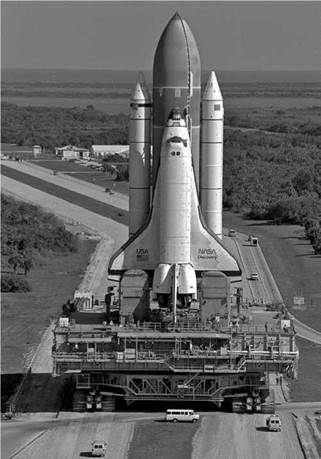Unresolved Issues
There were two major issues with respect to the space shuttle left unresolved as the January 5 statement was issued. One was what means would be used to boost the shuttle orbiter off the launch pad. The other was the character of the budgetary commitment to the shuttle program being made by the Nixon administration. The first of these was resolved by early March; the second persisted over the next few years.
Which Booster?
NASA after January 5 began a rapid examination of four alternatives for lifting the shuttle orbiter off the launch pad: parallel burn solid rocket motors, series burn solid rocket motors, parallel burn recoverable pressure-fed boosters, or a single series burn pressure-fed booster. The two parallel burn configurations had their origin in the studies carried out by McDonnell Douglas and Grumman and resembled the thrust-assisted orbiter shuttle (TAOS) design suggested in Mathematica’s October memorandum.
The preference of NASA engineers as intensive booster studies began in January 1972 was one of the pressure-fed alternatives. The pressure-fed design was an invention of NASA’s engineers at the Marshall Space Flight Center; the German members of the engineering group who had been brought to the United States after World War II had career-long experience with liquid-fueled boosters. A division of labor between Houston, which would be in charge of developing the new shuttle orbiter, and Huntsville, which would be in charge of developing the new pressure-fed boosters in addition to the shuttle main engine and external propellant tank, made institutional sense. But the booster studies soon showed that developing the new pressure-fed booster would be more difficult than it had appeared at first glance and thus carried the possibility of higher costs and more technical risk than had been anticipated. The OMB kept pressure on NASA to select the booster option that had the least chance of cost overruns. Since there was extensive Air Force experience with solid-fueled rockets, OMB leaned in that direction. OMB was concerned whether "NASA could overcome its instinctive dislike" of solid rocket motors. But Don Rice’s "contractor source" told OMB that NASA headquarters was "insisting on an honest comparison."3
By early March NASA headquarters had made its choice—to go with solid rocket motors fired at liftoff in parallel with the orbiter’s engines to boost the shuttle off the launch pad. The "principal reason for going to the solids was the low technical risk and the approximate one half billion to one billion [dollar] savings" in development costs.
|
The final space shuttle configuration. (NASA photograph) |
In addition, NASA had discovered that it might be possible to recover, refurbish, and reuse the casings of the solid rocket motors; this "tilted the scales because they made the operational costs reasonable." On March 13, Don Rice told OMB’s George Shultz and Cap Weinberger that "we recommend acceptance" of the NASA choice; that recommendation was accepted, and the basic space shuttle configuration that would become so familiar over thirty years of shuttle flights was given a green light for development.4











